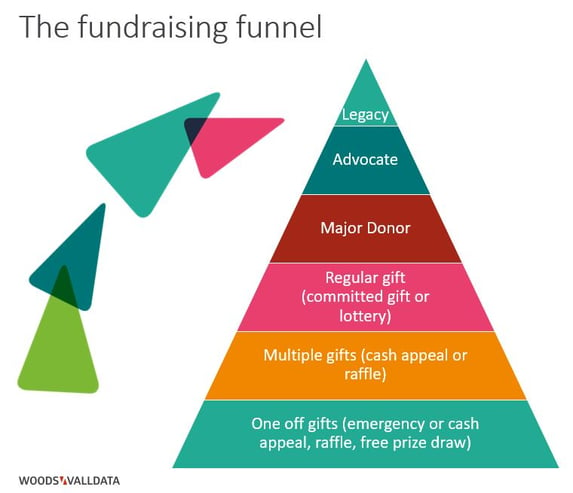
The Importance of Retention and Stewardship in Individual Giving Fundraising
When we think of developing our programmes and raising more income for our cause, pursuing new supporters often takes centre stage.
However, charities are increasingly seeing the rise in importance of retention and stewardship activities to build relationships with supporters after that initial contact.
In this article, we will explore why strategic retention and stewardship are crucial elements of successful individual giving fundraising campaigns.
The fundraising funnel
Shifts towards stewardship in charities are rooted in the recognition that acquiring new supporters can be expensive, especially in the wake of challenges like the COVID-19 pandemic and cost-of-living crisis. As a result, the focus has shifted to keeping the supporters once they are acquired, rather than just spending on acquisition to mitigate attrition.
You might like to think about the journey with supporters as a fundraising funnel that guides supporters through various stages: from initial acquisition – maybe through a cash appeal - to becoming regular givers, and ultimately, inspiring legacy contributions.

We appreciate that no journey is as linear as this, but the funnel can help provide a clear hierarchy of goals and guide the allocation of resources. As supporters progress through the funnel, the focus shifts from transactional retention to long-term relationship building and stewardship.
The role of data and feedback
An essential component of effective retention and stewardship strategies is data-driven decision-making. You will be collecting data on your supporters – whether that is simply based on first gift, giving frequency, average gift value and other transactional information, or other, richer data sources.
You might consider conducting a survey to gather insights from supporters, as an example. These surveys can provide valuable feedback about how supporters perceive your charity, its mission, and the impact of their contributions. Such feedback helps tailor communications and engagement efforts to match supporter expectations.
A recent survey of supporters by a leading UK charity, for instance, revealed that while supporters trust the organization's use of funds, there is room for improvement in communicating the charity's cause and understanding supporter motivations. This highlights the importance of personalising communication and provides guidance on where to focus future efforts.

Implementing effective retention and stewardship
Implementing successful retention and stewardship strategies requires careful planning and ongoing evaluation. You might want to map your supporter journeys and look at optimising communication touchpoints. Regular audits of existing communications can also help identify areas for improvement and prevent duplication of efforts.
Whilst it's important to have a structured approach, flexibility is also key. External factors such as changes in the economic environment or supporter preferences can influence retention strategies.
For example, one charity responded to rising living costs by creating a cancellation pack for regular givers. This helped mitigate attrition rates and highlight other ways for supporters to get involved with the charity, thereby further strengthening the relationship rather than losing the supporter altogether.
Here are some practical steps to consider:
1. Know your supporters
Understand your supporters' motivations, preferences, and values to create tailored experiences that resonate deeply.
2. Share engaging content
Provide content that informs, inspires, and evokes emotion. Share success stories, updates, and meaningful achievements that showcase the tangible impact of supporters' contributions.
3. Show gratitude and appreciation
Regularly express gratitude for supporters' involvement. Let them know that their contributions are instrumental in driving positive change.
4. Personalise communications
Use personalised communication channels and messages that align with supporters' preferences. This enhances the sense of connection and relevance your supporters have with your charity.
5. Allow for feedback and adaptation
Actively seek feedback from supporters about their experiences and preferences. Use this feedback to adapt and refine your stewardship approach.
6. Keep asking
Incorporate well-planned asks that align with supporters' interests and the journey they're on. The asks should feel natural and meaningful, not transactional.
Measuring the impact
Measurement is integral to any fundraising strategy. Conducting split tests and analysing response rates to different communication strategies can provide insights into what works best for different segments of supporters.
There may, however, be occasions when testing cannot be done. The impact of retention and stewardship efforts can then be quantified through comparing attrition rates, second gift rates, and so on to a previous year – although these can only be guides rather than statistical fact.
Incorporating a mix of quantitative and qualitative measurements allows the organization to assess the overall health of the donor base and the success of retention efforts. Long-term commitment, such as legacy pledges, can be seen as the ultimate indicator of the success stewardship.

Enhance individual giving fundraising with Woods Valldata
In the evolving landscape of fundraising, retention and stewardship are becoming increasingly vital. A strategic focus on retaining and nurturing existing supporters not only yields financial benefits but also deepens your charity's impact and strengthens donor relationships.
With a strong understanding of supporter motivations, leveraging data, and adapting to changing circumstances, charities can build a sustainable foundation for their fundraising efforts.
Want to discover more? Find out more about approaches in retention and stewardship through our webinar, now available on demand.
Woods Valldata are here for you and there for your supporters. We offer an unrivalled range of services which can support your retention and stewardship activities, including response handling, digital scanning and data capture of supporter responses (including supporter surveys), and making complex, automated thanking of supporters simple using the SmartThank Platform.
We’ve been helping charities for years, from establishing successful lotteries to aiding with direct debit migrations.
Contact us today to find out more about our innovative strategies and how we can help you enhance your fundraising. We look forward to speaking with you!
Categories
- charity fundraising (50)
- Lottery (40)
- Income Generation for Charities (38)
- Raffle (37)
- Appeal response handling (31)
- Response Handling (27)
- fundraising insights (23)
- charity gaming (19)
- charity raffle (17)
- Fulfilment (16)
- charity insights (16)
- Compliance (12)
- Company News (11)
- benchmarks (10)
- Direct Debit (9)
- Services (8)
- creating a fundraising strategy (8)
- Gambling Act (5)
Archives
- March 2020 (5)
- May 2022 (4)
- October 2022 (4)
- January 2023 (4)
- June 2023 (4)
- May 2024 (4)
- June 2024 (4)
- March 2021 (3)
- April 2021 (3)
- July 2023 (3)
- August 2023 (3)
- April 2024 (3)
- July 2024 (3)
- November 2025 (3)
- June 2020 (2)
- August 2020 (2)
- October 2020 (2)
- November 2020 (2)
- November 2021 (2)
- January 2022 (2)
- February 2022 (2)
- February 2023 (2)
- March 2023 (2)
- September 2023 (2)
- December 2023 (2)
- February 2024 (2)
- March 2024 (2)
- February 2025 (2)
- July 2025 (2)
- December 2025 (2)
- June 2015 (1)
- November 2017 (1)
- February 2020 (1)
- April 2020 (1)
- May 2020 (1)
- July 2020 (1)
- September 2020 (1)
- May 2021 (1)
- June 2021 (1)
- August 2021 (1)
- September 2021 (1)
- October 2021 (1)
- December 2021 (1)
- March 2022 (1)
- April 2022 (1)
- June 2022 (1)
- July 2022 (1)
- August 2022 (1)
- September 2022 (1)
- December 2022 (1)
- May 2023 (1)
- October 2023 (1)
- November 2023 (1)
- January 2024 (1)
- September 2024 (1)
- January 2025 (1)
- March 2025 (1)
- September 2025 (1)
- October 2025 (1)
